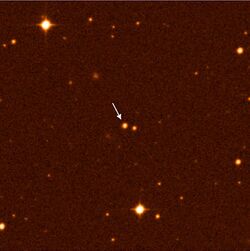Astronomy:HE0107-5240
| Observation data Epoch J2000.0 Equinox (celestial coordinates) | |
|---|---|
| Constellation | Phoenix |
| Right ascension | 01h 09m 29.1s[1] |
| Declination | −52° 24′ 20″ |
| Apparent magnitude (V) | 15.86 |
| Astrometry | |
| Distance | 36000 ly |
| Details | |
| Metallicity [Fe/H] | −5.2[citation needed] dex |
| Other designations | |
HE 0107-5240, 2MASS J01092916-5224341. | |
| Database references | |
| SIMBAD | data |
HE0107-5240 is an extremely metal-poor Population II star, located roughly 36000 light-years away from the Earth, that has a mass of approximately 80% of the mass of the Sun. It is one of the most metal-poor stars known in our Galaxy, with a metallicity [Fe/H] = −5.2±0.2; i.e. it has just 1/160000 of the metal that the Sun has. Because of its very low metallicity, it is believed to be one of the earliest Population II stars to have formed. If so, then it is also very old, with an age of roughly 13 billion years. Because the star is not completely metal-free, it does not belong to the first generation of stars (the hypothetical Population III). These stars converted the pristine hydrogen, helium, and lithium formed by the Big Bang into heavier elements, such as carbon, oxygen, and metals.
The star is relatively small for a star of the early universe, which accounts for its old age: massive stars die quickly. To help explain why this star is so small, it is hypothesized it was once part of a binary star system.[2] [3]
HE0107-5240 was found by Norbert Christlieb and colleagues at the University of Hamburg in Germany as a byproduct of the Hamburg/ESO Survey for faint quasars with the 1m ESO Schmidt telescope. Follow-up observations were made at the Siding Spring 2.3 m Telescope and high-resolution spectra were taken at the European Southern Observatory in Chile , using one of the units of the Very Large Telescope. In 2005, a second star with an even smaller iron abundance, HE 1327-2326 ([Fe/H]=-5.4), was found, also in the Hamburg/ESO survey. In 2014 an even more metal poor star was announced: SMSS J031300.36−670839.3.[4]
See also
- Ultra low metallicity / ultra metal poor stars
References
- ↑ A. Udalski, G. Pietrzynski, M. Szymanski, M. Kubiak, K. Zebrun, I. Soszynski, O. Szewczyk, and L. Wyrzykowski (June 2003). "The Optical Gravitational Lensing Experiment. Additional Planetary and Low-Luminosity Object Transits from the OGLE 2001 and 2002 Observational Campaigns". Acta Astronomica 53: 133–149. Bibcode: 2003AcA....53..133U.
- ↑ Lau, Herbert H. B.; Stancliffe, Richard J.; Tout, Christopher A. (2007). "Carbon-rich extremely metal poor stars: signatures of Population III asymptotic giant branch stars in binary systems". MNRAS 378: 563–568. doi:10.1111/j.1365-2966.2007.11773.x. Bibcode: 2007MNRAS.378..563L.
- ↑ Suda, Takuma; Aikawa, Masayuki; Machida, Masahiro N.; Fujimoto, Masayuki Y.; Iben, Icko, Jr. (2004). "Is HE 0107-5240 A Primordial Star? The Characteristics of Extremely Metal-Poor Carbon-Rich Stars". Astrophysical Journal 611: 476–493. doi:10.1086/422135. Bibcode: 2004ApJ...611..476S.
- ↑ S. C. Keller, M. S. Bessell, A. Frebel, A. R. Casey, M. Asplund, H. R. Jacobson, K. Lind, J. E. Norris, D. Yong, A. Heger, Z. Magic, G. S. Da Costa, B. P. Schmidt, P. Tisserand (2014). "A single low-energy, iron-poor supernova as the source of metals in the star SMSS J031300.36−670839.3". Nature 506: 463–466. doi:10.1038/nature12990. ISSN 0028-0836. PMID 24509711. Bibcode: 2014Natur.506..463K.
- Christlieb N., Bessell M.S., Gustafsson B., Korn A., Barklem P.S., Karisson T., Mizuno-Wiedner M., Rossi S., "A stellar relic from the early Milky Way", Nature, 419, 904-906 (2002)
External links
- SIMBAD-Entry (SIMBAD)
- Hamburg/ESO survey (Christlieb+, 2008)
- Relic Star Found, Pointing Way to Dawn of Time (Space.com)
- VLT UVES Observes Most Metal-Deficient Star Known (European Southern Observatory)
- he0107-5240


